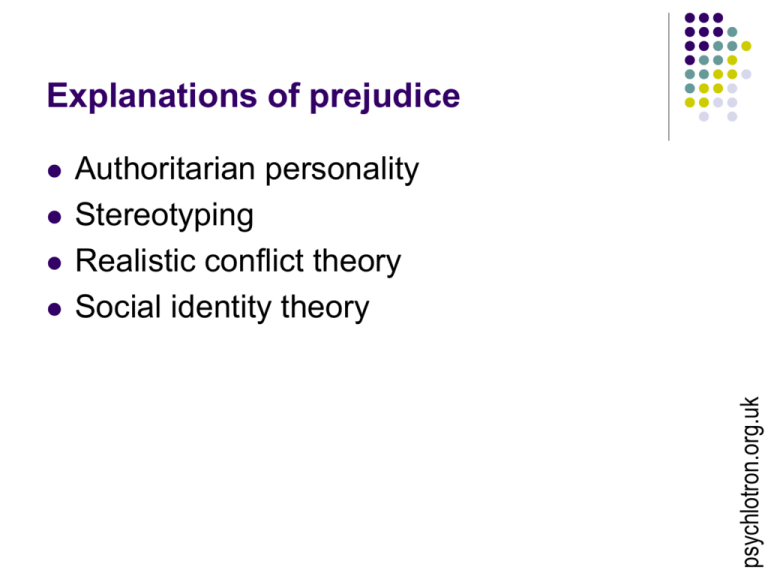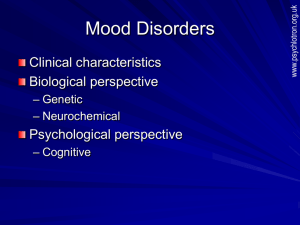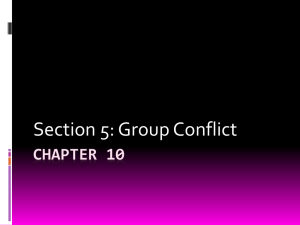Explanations of prejudice slides
advertisement

Explanations of prejudice Authoritarian personality Stereotyping Realistic conflict theory Social identity theory psychlotron.org.uk Authoritarian personality Prejudice is caused by psychological processes within the individual Prejudiced people have a particular personality type psychlotron.org.uk Authoritarian personality Personality traits: Status oriented Conventional and conformist Suspicious & hostile Caused by: Harsh and punitive upbringing resulting in repressed hostility towards parents – this is displaced onto ‘inferior’ people psychlotron.org.uk Authoritarian personality Adorno et al (1950) Developed attitude scales to measure authoritarianism (F-Scale), anti-Semitism & ethnocentrism Found significant +ve correlations: F-Scale w/anti-Semitism: +0.8 F-Scale w/ethnocentrism: +0.65 Shows strong relationship between authoritarianism & prejudice psychlotron.org.uk Authoritarian personality Problems with Adorno et al’s research: F-Scale consisted only of positive items – response bias? Theory developed using projective attitude measures – researcher bias? Correlation does not prove causation – authoritarianism & prejudice may occur together, but it doesn’t follow that one causes the other psychlotron.org.uk Authoritarian personality Problems with the theory: Prejudice within a society can change very quickly – e.g. Germany in 1930s, US following Pearl Harbor – not consistent with Adorno’s idea that prejudice always goes back to childhood. Cannot easily account for prejudice affecting large groups/whole societies e.g. South Africa under apartheid psychlotron.org.uk Stereotyping Prejudice is caused by psychological processes within the individual, but linked to influences from society Prejudice arises because people have a tendency to think in ways that minimise mental effort psychlotron.org.uk Stereotyping Stereotypes = a sort of mental shorthand for making sense of people: People classified as belonging to groups defined by a single characteristic All members of group assumed to have same characteristics/behaviour Content of stereotypes is learned from society (family, peers etc.) Prejudice is the result of negative stereotyping psychlotron.org.uk Stereotyping Once acquired, stereotypes tend to be selfconfirming because: We may avoid members of groups we stereotype We tend to ignore or ‘explain away’ info that is inconsistent with stereotypes We may act in ways (rude, hostile) that cause others to behave consistently with our stereotypes psychlotron.org.uk Stereotyping Jane Eliot’s study of prejudice (blue eyesbrown eyes) Brown eyed children told they were better, smarter, given privileges; Brown eyes assumed superior attitude; blue eyes started to perform poorly Shows how quickly stereotypes start shaping attitudes & behaviour psychlotron.org.uk Stereotyping Greenberg & Pyzczynsky (1985) White students rated performance of Black debaters more poorly than White if they had heard a racist comment Stereotypes increase prejudice but only when activated Minard (1952) Stereotypes can be suppressed but only when social norms support this psychlotron.org.uk Stereotyping Stereotypes often accompany & support prejudice but may not cause it Social processes (e.g. group norms) influence the expression of stereotyped thinking Jane Eliot’s study is consistent with other theories (esp. social identity) psychlotron.org.uk Realistic conflict theory Prejudice is caused by social processes occurring between groups of people Prejudice causes changes in individual thinking (e.g. stereotyping) but these are strongly linked to group processes psychlotron.org.uk Realistic conflict theory Prejudice arises when two or more social groups compete for the same scarce/valued resource Inbuilt tendency to favour in-group members; become hostile toward out-group members Deny resources to out-group thereby ensuring greater share for in-group/self psychlotron.org.uk Realistic conflict theory Sherif et al (1961): the ‘Robber’s Cave’ study Competition & conflict artificially stimulated between two groups of boys at a summer camp Resulted in negative stereotyping of out-group; hostile and aggressive acts toward out-group members Prejudice persisted even after competition ended psychlotron.org.uk Realistic conflict theory Questions over the validity of the Robber’s Cave study: Unrepresentative samples (US American boys; limited numbers)? Contrived & artificial situation? Competition does not always create prejudice (e.g. Tyerman & Spencer’s study with UK scouts) psychlotron.org.uk Realistic conflict theory RCT predicts that prejudice should intensify during times of economic hardship. This confirmed many times: Dollard (1938) prejudice against German immigrants in US town increased as jobs grew scarce Jacobs & Landau (1971) US prejudice against Chinese increased & decreased in line with prosperity & competition psychlotron.org.uk Realistic conflict theory Competition certainly increases prejudice. However: Prejudice can exist in the absence of competition (e.g. apartheid South Africa) Competition does not automatically lead to prejudice; it depends on the nature & relationship of the groups involved (Tyerman & Spencer, 1983) psychlotron.org.uk Social identity theory Prejudice is caused by social processes occurring between groups of people It happens because of the way our sense of self (identity) is determined by the groups we belong to psychlotron.org.uk Social identity theory We derive our identity in part from the social groups we belong to (culture, religion, profession, football team…) Consequently, we feel better about ourselves when we feel good about our social groups We get to feel good about our social groups by comparing them favourably with other groups psychlotron.org.uk Social identity theory Prejudice is a strategy for achieving & maintaining self-esteem: We will tend to be biased towards in-group members and against out-group members We will pay more attention to criteria that make our in-groups look better than salient out-groups psychlotron.org.uk Social identity theory Tajfel et al (1982) assigned schoolboys to ‘meaningless’ groups; allowed them to allocate points/money to own & other group PPs always chose a strategy that would allocate less to other group than to own even when this meant getting less overall for their own group Shows in-group bias in the absence of competition & with only a ‘minimal group’ psychlotron.org.uk Social identity theory Favouritism towards in-group: Levine et al (2005) – Man-U & Liverpool fans more likely to help an injured person if wearing own team’s colours Football fans – self-esteem linked to team performance; tendency to denigrate other teams/fans (esp. if local); tendency to emphasise other ways of being superior if team doing poorly (e.g. ‘Chelsea fans are glory hunters, not real fans’ etc.) psychlotron.org.uk Social identity theory Plenty of support for main propositions. Two main problems: Tendency to favour in-group may be culturally specific, not universal (Wetherall, 1982) Most studies show bias towards in-group – not necessarily the same thing as prejudice psychlotron.org.uk



